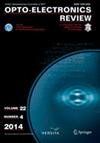Dual-band absorption of a GaAs thin-film solar cell using a bilayer nano-antenna structure
IF 0.9
4区 工程技术
Q3 ENGINEERING, ELECTRICAL & ELECTRONIC
引用次数: 0
Abstract
Article history: Received 16 Apr. 2020 Received in revised form 16 Jul. 2020 Accepted 17 Jul. 2020 The paper presents a dual-band plasmonic solar cell. The proposed unit structure gathers two layers, each layer consists of a silver nanoparticle deposited on a GaAs substrate and covered with an ITO layer, It reveals two discrete absorption bands in the infra-red part of the solar spectrum. Nanoparticle structures have been used for lighttrapping to increase the absorption of plasmonic solar cells. By proper engineering of these structures, resonance frequencies and absorption coefficients can be controlled as it will be elucidated. The simulation results are achieved using CST Microwave Studio through the finite element method. The results indicate that this proposed dual-band plasmonic solar cell exhibits an absorption bandwidth, defined as the full width at half maximum, reaches 71 nm. Moreover, It can be noticed that by controlling the nanoparticle height above the GaAs substrate, the absorption peak can be increased to reach 0.77.采用双层纳米天线结构的砷化镓薄膜太阳能电池的双波段吸收
文章历史:收稿日期:2020年4月16日收稿日期:2020年7月17日收稿日期:2020年7月17日所提出的单元结构聚集了两层,每层由沉积在GaAs衬底上的银纳米颗粒组成,并覆盖有ITO层,它在太阳光谱的红外部分显示出两个离散的吸收带。纳米粒子结构已被用于光捕获,以增加等离子体太阳能电池的吸收。通过对这些结构进行适当的工程设计,共振频率和吸收系数可以得到控制。利用CST Microwave Studio通过有限元法获得了仿真结果。结果表明,该双频等离子体太阳能电池的吸收带宽达到71 nm,即最大半宽处的全宽度。此外,可以注意到,通过控制纳米颗粒在GaAs衬底上方的高度,可以提高吸收峰,达到0.77。
本文章由计算机程序翻译,如有差异,请以英文原文为准。
求助全文
约1分钟内获得全文
求助全文
来源期刊

Opto-Electronics Review
工程技术-工程:电子与电气
CiteScore
1.90
自引率
12.50%
发文量
0
审稿时长
>12 weeks
期刊介绍:
Opto-Electronics Review is peer-reviewed and quarterly published by the Polish Academy of Sciences (PAN) and the Association of Polish Electrical Engineers (SEP) in electronic version. It covers the whole field of theory, experimental techniques, and instrumentation and brings together, within one journal, contributions from a wide range of disciplines. The scope of the published papers includes any aspect of scientific, technological, technical and industrial works concerning generation, transmission, transformation, detection and application of light and other forms of radiative energy whose quantum unit is photon. Papers covering novel topics extending the frontiers in optoelectronics or photonics are very encouraged.
It has been established for the publication of high quality original papers from the following fields:
Optical Design and Applications,
Image Processing
Metamaterials,
Optoelectronic Materials,
Micro-Opto-Electro-Mechanical Systems,
Infrared Physics and Technology,
Modelling of Optoelectronic Devices, Semiconductor Lasers
Technology and Fabrication of Optoelectronic Devices,
Photonic Crystals,
Laser Physics, Technology and Applications,
Optical Sensors and Applications,
Photovoltaics,
Biomedical Optics and Photonics
 求助内容:
求助内容: 应助结果提醒方式:
应助结果提醒方式:


